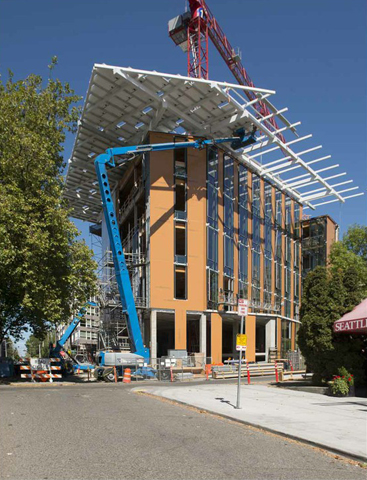
Bullitt Center under construction (John Stamets)
Seattle punctuated Earth Day 2013 with the dedication of what is touted as "the world's greenest commercial building."
Seattle University will be among those testing that claim.
Washington Gov. Jay Inslee and Seattle Mayor Mike McGinn were among dignitaries at the grand opening of the Bullitt Center, a $30 million, six-story, 50,000-square-foot office building that will generate all its own electricity, capture and store rain for all its water needs, compost its own waste, and treat its greywater on-site.
Faculty and students of Seattle University's recently founded Center for Environmental Justice and Sustainability will be testing the efficacy of the new building's third-floor balcony "wetland" at processing sullage from sinks and showers. The water quality monitoring is required by the city health department.
It will be a short walk, as the CEJS offices have moved to the innovative structure itself, located at 15th Avenue and Madison Street, about two blocks from the university's campus in Seattle's Capitol Hill neighborhood.
In addition to its waste, water and power initiatives, the Bullitt Center observed strict green building protocols in its construction. It is reported to be the largest structure to qualify for the Living Building Challenge, a stringent standard in sustainable building.
According to the Bullitt Center website, "To be certified as a Living Building, a structure is required to be self-sufficient for energy and water for at least 12 continuous months and to meet rigorous standards for green materials and for the quality of its indoor environment."
Among its imperatives, the challenge demands projects support a pedestrian-, bicycle- and transit-friendly lifestyle; promote health of occupants via inviting stairways, good ventilation, natural light and resource sharing; and not contain any "Red List" hazardous materials such as PVC, cadmium, lead, mercury and hormone-mimicking substances, all common in building components.
The Bullitt Center was developed by the Bullitt Foundation, a long-established organization with a mission "to safeguard the natural environment by promoting responsible human activities and sustainable communities in the Pacific Northwest."
Foundation president Denis Hayes is a well-known environmentalist who was primary coordinator of the first Earth Day in 1970 and directed the federal Solar Energy Research Institute during the administration of President Jimmy Carter.
Launched in January after nearly two years of preparation and planning, Seattle University's Center for Environmental Justice and Sustainability will focus on "innovative and interdisciplinary scholarship, teaching, and learning in environmental sustainability and its intersection with issues of justice," its website states.
The center's director, Phillip L. Thompson, told NCR the center will also sponsor community outreach efforts. He cited an "environmental literacy project" with Hawthorne Elementary as an example.




